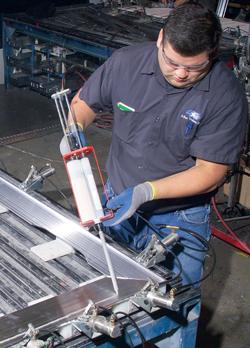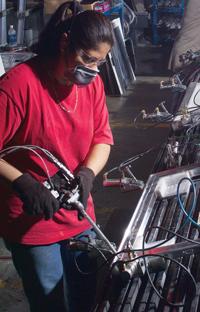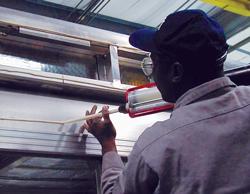Senior Technical Representative
- FMA
- The Fabricator
- FABTECH
- Canadian Metalworking
Categories
- Additive Manufacturing
- Aluminum Welding
- Arc Welding
- Assembly and Joining
- Automation and Robotics
- Bending and Forming
- Consumables
- Cutting and Weld Prep
- Electric Vehicles
- En Español
- Finishing
- Hydroforming
- Laser Cutting
- Laser Welding
- Machining
- Manufacturing Software
- Materials Handling
- Metals/Materials
- Oxyfuel Cutting
- Plasma Cutting
- Power Tools
- Punching and Other Holemaking
- Roll Forming
- Safety
- Sawing
- Shearing
- Shop Management
- Testing and Measuring
- Tube and Pipe Fabrication
- Tube and Pipe Production
- Waterjet Cutting
Industry Directory
Webcasts
Podcasts
FAB 40
Advertise
Subscribe
Account Login
Search
Adhesive bonding broadens the fabricator’s toolbox
Structural adhesives become a viable metal joining alternative
- By Michael Verdi
- April 1, 2011
- Article
- Assembly and Joining

Figure 1: Acrylic adhesive can join bare metal to bare metal, making it a viable alternative for previously welded or riveted joints. Here, an operator uses a pneumatic-type cartridge gun to apply the adhesive.
It's about the bead. It should be smooth and consistent along the entire joint. Applying too much or too little introduces joint inconsistencies and potential problems. Ultimately, laying down a smooth and consistent bead gives the best chance of producing a structurally sound joint.
And by the way, this bead isn't a weld bead. It is structural adhesive, a bonding material that has come a long way in recent years.
These days structural adhesives introduce serious strength into a joint—up to 4,000 PSI. Destructive tests have shown that adhesive bonds perform well in both thin and thick metal. For plate, the base material's stiffness actually allows the adhesive bond to hold very well. On thin-gauge metal, a bond can exceed the metal's tensile strength. In pull-apart tests, the base metal itself rips apart while the bond area remains intact.
Adhesive bonding is not a go-to solution for all joining problems. Butt joints aren't ideal for adhesives; neither are grooves and fillets. And no one would use adhesives on bridges or other load-bearing components. An adhesive-bond joint can't undergo nondestructive testing either, so such bonding would be impractical for code-level work requiring these tests.
While adhesives may not replace all welding and riveting, they can complement the processes (see Figures 1 and 2). Every joining technology has its positives and negatives, and this includes mechanical fastening, welding, and adhesive bonding. The last is least well-known, probably because structural adhesives are one of the newer tools in a metal fabricator's toolbox.
Adhesive Types
Older structural adhesives don't offer a lot for fabricators looking to join one bare metal part to another. Epoxies have the longest history, and they are still a viable material in some situations. Environmentally friendly, epoxies also tend to resist chemical reactions. They play an important role in some aerospace applications in which high-temperature chemical resistance is paramount. They can join plastic, plated, and painted metals, as well as rubber—but those needing to join bare metal components should look elsewhere. The same goes for urethane adhesives, which, like epoxies, have plenty of other applications, such as composite and plastic bonding in the automotive industry.
Acrylic adhesives offer fabricators the most bonding options. Unlike other adhesives, acrylics can bond bare metal to bare metal and hence can join components that in the past would have been welded or riveted. At the molecular level, bare metal (and all surfaces to a degree) has microsized peaks and valleys, and it is acrylic's ability to settle into these peaks and valleys to form a complete bond that makes the adhesive work so well with bare metal (as well as many other materials). It's a molecular attraction. The adhesive molecules are attracted to the bare metal's carbon molecules on the surface, and this attraction draws the bonding material into these microvalleys.
Analyzing the Bond
Like soldering and brazing, no fusion takes place when using adhesives. It is bonding, not welding, and a distinct bond line remains. However, unlike soldering or brazing, adhesive bonding doesn't require heat. In many cases, an adhesive bond actually can be stronger than a soldered or brazed joint.
Adhesives require a certain amount of intimate contact between component surfaces. For many components, the contact surface between components should be at least 0.5 inch wide, but the precise width depends on the application. The joint design should allow for the so-called "squeeze-out" effect, which produces a tiny bead squeezing out from between the clamped, mated surfaces. An adhesive joint should have close contact—bonding a panel or flat sheet to a square-tube frame, for instance, or an overlap joint between two sheets. The final bond also must be clamped or otherwise held in place for a period of time so the adhesive can cure.
An operator lays a bead down, places another sheet on top, and squeezes the two materials together. A bead of adhesive will squeeze out from between the material. The resulting bond should be only 0.010 to 0.020 in. deep, which is why the process requires intimate contact between the two materials—closer than joint designs such as grooves and fillets would allow. The more consistent the squeeze-out bead's shape is along the length of the joint, the better the bond.
In this respect, such bonding resembles welding. Weld joints require just enough weld metal, no more and no less. Too little weld metal and the joint may be susceptible to defects such as incomplete fusion; too much may induce excess distortion and other defects from too much heat. Adhesive bonding is a cold process and so not susceptible to defects caused by excess heat. However, the worker still must apply a smooth bead to ensure consistent holding strength. This becomes especially apparent when joining thin sheet. Too much adhesive material in one area can cause bond strength inconsistencies; too little may provide insufficient strength.
The amount of adhesive to apply depends on the job. Adhesive suppliers should provide calculators to determine the precise amount. For one job, a worker may apply a 0.125-in.-wide bead along the center of a 0.5-in.-wide longitudinal overlap joint. After the two components are squeezed together with clamps, that small bead should spread over the entire 0.5-in. joint area, revealing a tiny bead squeezed out at the joint edges. Between the two overlapped components should be an extremely thin layer of adhesive—again, between only 0.010 and 0.020 in. deep.
Besides overlap joints, adhesives work well with any configuration that results in close contact between materials, and this includes self-fixturing joints such as certain tongue-and-groove or tab-and-slot designs. In fact, self-fixturing joint designs can make joining simpler simply because the material need not be fixtured or held in place during the required curing.
Two Parts
Acrylic adhesives are two-part mixtures, which is why the application guns have two cartridges (see Figure 1) or feeding tubes. One side is the resin; the other is the accelerator. Deposited alone, the resin does nothing other than create a gooey mess on the material surface. However, when mixed at the proper ratio with the accelerator, chemical reactions take place that induce bonding.
Adhesive guns mix the resin and accelerators in several ways, depending on the gun type and amount of adhesives involved. Longer guns often use static mixers in which the resin and accelerator are pushed into a chamber with enough space for the two materials to mix thoroughly. Other guns have a spiral mixer in which the resin and accelerator are pushed through a spiral passage and overlapped together, mixing the two before the adhesive emerges from the gun tip. Most acrylic adhesives use 4 parts resin to 1 part accelerator, but 2-to-1, 10-to-1 (2 and 10 parts resin, respectively), and many other ratios also are used. The exact ratio depends, again, on the application.
Some accelerators can cure a bond in four minutes; others can take as long as 40 minutes. Most adhesive bonds take on average 15 minutes to cure. Temperature can affect curing time too; workers can apply heat after bonding to speed curing, for example. But when it comes to reducing curing time, proprietary ingredients of those accelerators have the greatest impact.
Cost Considerations
Though adhesives do require some time for curing, they also may eliminate downstream processes such as deburring and hand grinding, which happen to be some of the most labor-intensive areas on the shop floor.
In terms of consumable costs, welding wire and adhesive costs both vary depending on the volume purchased. As volume rises, the per-unit price drops. Unit costs of adhesive in cartridge systems, with cartridges built into the gun itself, are more than bulk systems that have guns attached to a central adhesive tank (see Figure 3).
If adopting adhesive joining for the first time, a company must purchase equipment to dispense it. Electricity usage is another ROI factor; welding power sources require it, while pneumatic adhesive dispensing systems don't. Rework from bad welds also may factor in. But perhaps more than anything else, if adhesives eliminate an entire process such as hand grinding, the ROI can happen very quickly.
Making the Transition
When transitioning to adhesives, many look for the low-hanging fruit first, those joints that don't require any redesign and for which adhesives would reduce cost while maintaining or improving quality. Adhesives would be simply a drop-in replacement. Only after tackling those drop-in replacements should managers consider any product redesign—and again, the effort makes business sense only if adhesive bonding reduces costs and maintains or improves quality. If welding or mechanical fastening remains the most cost-effective joining method, the process should be left alone.

Figure 3: In this application, workers use an acrylic adhesive delivered through tubes connected to centralized bulk tanks.
When considering structural adhesives, it helps to take a holistic view. It's true that initial adoption usually involves those drop-in replacements for welding or riveting. However, bringing adhesive bonding in-house can have long-reaching effects for a business. It broadens a shop's capabilities, especially when it comes to joining dissimilar materials: mild steel; high-strength, low-alloy (HSLA) steel; galvanneal; plastic; rubber; composites; and so on. Such capability may help job shops bid competitively for more types of work. In product line manufacturing, it may broaden product design options that in turn could improve quality and reduce manufacturing costs.
Communicating those long-reaching effects to personnel can help with another important factor: the cultural implications. Adhesive bonding doesn't mean the end for all riveting and welding. In fact, it would be a waste to adopt it in instances where welding, riveting, or another joining method is more cost-effective. Adhesive bonding simply is another process alternative—and like anything else, if it makes business sense to use, it should become part of the business.
Images courtesy of LORD Corporation.
About the Author
Related Companies
subscribe now

The Fabricator is North America's leading magazine for the metal forming and fabricating industry. The magazine delivers the news, technical articles, and case histories that enable fabricators to do their jobs more efficiently. The Fabricator has served the industry since 1970.
start your free subscription- Stay connected from anywhere

Easily access valuable industry resources now with full access to the digital edition of The Fabricator.

Easily access valuable industry resources now with full access to the digital edition of The Welder.

Easily access valuable industry resources now with full access to the digital edition of The Tube and Pipe Journal.
- Podcasting
- Podcast:
- The Fabricator Podcast
- Published:
- 04/16/2024
- Running Time:
- 63:29
In this episode of The Fabricator Podcast, Caleb Chamberlain, co-founder and CEO of OSH Cut, discusses his company’s...
- Trending Articles
AI, machine learning, and the future of metal fabrication

Employee ownership: The best way to ensure engagement

Steel industry reacts to Nucor’s new weekly published HRC price

Dynamic Metal blossoms with each passing year

Metal fabrication management: A guide for new supervisors

- Industry Events
16th Annual Safety Conference
- April 30 - May 1, 2024
- Elgin,
Pipe and Tube Conference
- May 21 - 22, 2024
- Omaha, NE
World-Class Roll Forming Workshop
- June 5 - 6, 2024
- Louisville, KY
Advanced Laser Application Workshop
- June 25 - 27, 2024
- Novi, MI



























